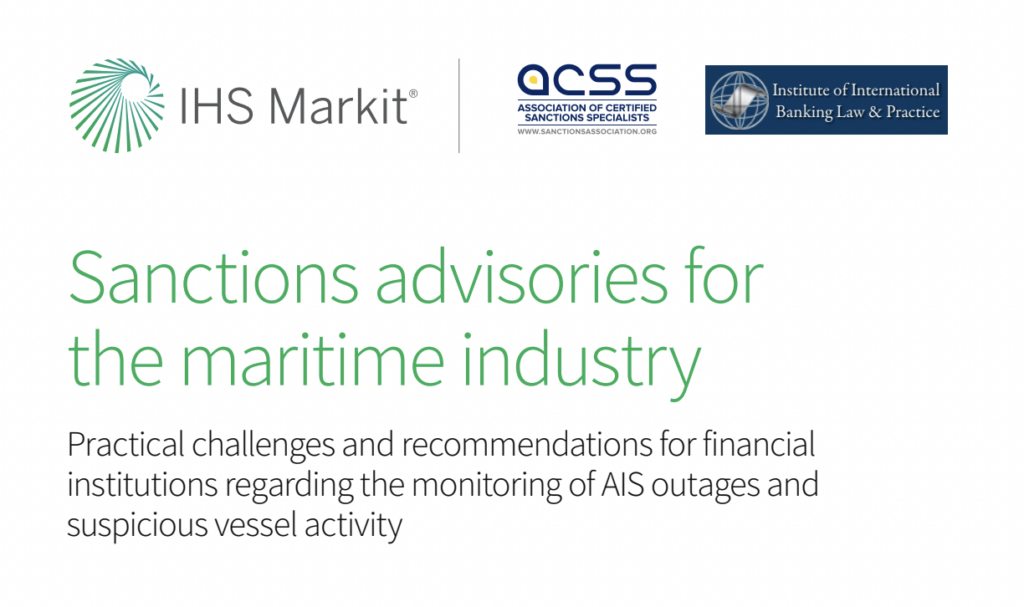Listen to this podcast on Spotify, Apple Podcasts, Podbean, Podtail, ListenNotes, TuneIn
For financial institutions, the decision to investigate a client for potential sanctions violations has always been more of an art than a science. And this is even more true when that decision is based on shipping activity.
Even today, with a wealth of new tracking and communications technologies available to us, pulling the trigger on such investigations remains a complex and high-stakes process.
As executive director of the Association of Certified Sanctions Specialists (ACSS), Saskia Rietbroek works with a range of banks, shipping companies, and manufacturers to improve sanctions compliance in trade and trade finance.
Michael Byrne, CEO of the Institute of International Banking Law and Practice (IIBLP), also works with banks both large and small to improve sanctions compliance.
This month, the IIBLP and ACSS teamed up with IHS Markit to publish a white paper on Sanctions advisories for the maritime industry.

Who sets the sanctions?
At the ACSS and IIBLP, Rietbroek and Byrne’s work involves monitoring maritime sanctions guidelines issued by national agencies, and translating these into practical steps for members and clients.
In the US, maritime sanctions are controlled by the US Treasury Office of Foreign Assets Control (OFAC), and in the UK, its counterpart is the Office of Financial Sanctions Implementation (OFSI).
As Rietbroek points out, neither OFAC or OFSI is a bank or maritime regulator, but all parties involved in international trade must nonetheless be aware of their decisions.
“OFAC can impose hefty fines on not just banks, but also on other sectors,” she said. “So maritime shipping companies are as exposed to these penalties and fines as their banks are.
“Sometimes, when we talk to our members from smaller companies, they will say: ‘Well, we are not really up on this topic, so we just wait for our bank to catch it’. But by that point it’s too late.”
Reasons to be cautious: Ship-to-ship transfers
In 2020, both OFAC and OFSI issued new guidance designed to combat illegal ship-to-ship transfers.
Despite the new guidance, however, Byrne said that many banks and other companies struggle to understand the risks of ship-to-ship transfers and their legal implications with regard to sanctions.
“At its most core level, a ship-to-ship transfer is the transferring of goods or cargo between two ships out in the water,” said Byrne.
“Whether it’s the transfer of a container, liquid crude, iron ore, or even bulk goods, it’s perfectly legal, and it happens all the time.”
Some areas are prime territory for ship-to-ship transfers, such as the low, calm waters around Malta, where many such transfers take place.
There is also a specific type of ship-to-ship transfer known as a transshipment, whereby goods or cargo are transferred from ocean-going vessels to smaller regional-sized vessels.
“This is all totally normal, but it gets taken advantage of by bad actors,” said Byrne.
“The most important thing that we really want people to look out for is that these transfers can take place where it isn’t legal, or transfers can be made to vessels owned by sanctioned countries such as Iran or North Korea.”
In most cases, the aim of the sanctions busters is simply to make money, and in many cases, turning off their automatic identification system (AIS) is part of the plan.
GRAPH: #Iran's⬆️in oil exports coincides with⬆️use of non-sanctioned foreign-flagged tankers. Many turn to @OFAC to see if a vessel is listed before doing business. @OFAC can help the maritime industry avoid sanctions risk by designating vessels @UANI’s identified. #UANIShipping pic.twitter.com/0Strw0sX3m
— UANI (@UANI) August 25, 2021
AIS: The good, the bad, and the ugly
AIS is a tracking system which broadcasts key information about a ship, which is picked up by either satellites or land-based antennas.
Such information includes the vessel identification number – either in the form of a Maritime Mobile Service Identity (MMSI) or an International Maritime Organization (IMO) number.
It also includes the vessel’s exact location based on latitude and longitude, the time of day, the direction the vessel is heading, its course, its speed, its draft, and the depth of the vessel in the water, based on the weight of the goods it is carrying.
As Byrne explains, the easiest way for a bad actor to manipulate a ship’s AIS is to switch it off, but this is easier said than done.
“AIS is not like a light switch that you can just turn on and off whenever you want,” he said. “It’s housed at the top of a vessel, so somebody’s got to go up in there, and it takes time to shut it down and crank it back up again.
“But if you are good at violating sanctions, you know all this, and you know when to turn it off, which is usually right when you’re away from the land-based antennas, because they provide almost instant feedback, whereas the satellites can take a few days for somebody to be able to actually use the data.”
AIS conjuring tricks
A more subtle technique than switching it off involves manipulating AIS data to mislead recipients.
For example, it is possible to spoof MMSI numbers, and it is also possible to change the flag under which a vessel is sailing.
Likewise, the reading as to how heavily laden a vessel is – which is taken manually – can be doctored.
One way to interpret such data with a more sceptical eye, as Byrne explains, is to look back at a vessel’s historical data and see how it compares with current data.
By doing so, this may throw up a pattern of red flags.
“If you check a vessel’s AIS right this second and it’s off, that may or may not mean anything, since we don’t have constant, truly up-to-the-second information,” he said.
In Byrne’s experience, one of the hardest places to get accurate and timely data is at the Port of Fujairah in UAE – a port so busy that there aren’t enough land-based antennas to allow for up-to-date tracking of every vessel nearby.
#Iran #OFAC #US #Sanctions #Shipping #Transport #Maritime#US’s Office of Foreign Assets Control (OFAC) issued yesterday June 8, 2020 a public note of Sanctions designating 121 #Ships (#Containers, #Tankers and others vessels) owned or tied to #IRISL and #E_sail (@LloydsList) pic.twitter.com/0OpVw0OkRH
— Mena Commodities ® (@MenaCommodities) June 9, 2020
“In many instances, if you can’t get a pingback from a vessel’s AIS in 24 hours or less, it’s probably not that risky,” he said.
“But the problem is, if you look at a map, you can see that it’s less than a day’s voyage from Fujairah to Bandar Abbas in Iran, and that’s plenty of time for a bad actor to disable their AIS, cruise on over, drop off some goods, collect some money, go back to Fujairah, turn it back on, and then ask somebody to prove they weren’t just sitting there the whole time.
“That in itself didn’t necessarily involve any manipulation: it was just a simple matter of turning off the AIS and making the run.
“But if you look at the history of that ship, you might find that they’ve done that several times in several different areas, or they might have a habit of just disappearing for a few days here and there.”
Listen to the full podcast to find out more about sanctions busters, sanctions compliance, and where to get help if your business is affected.
























